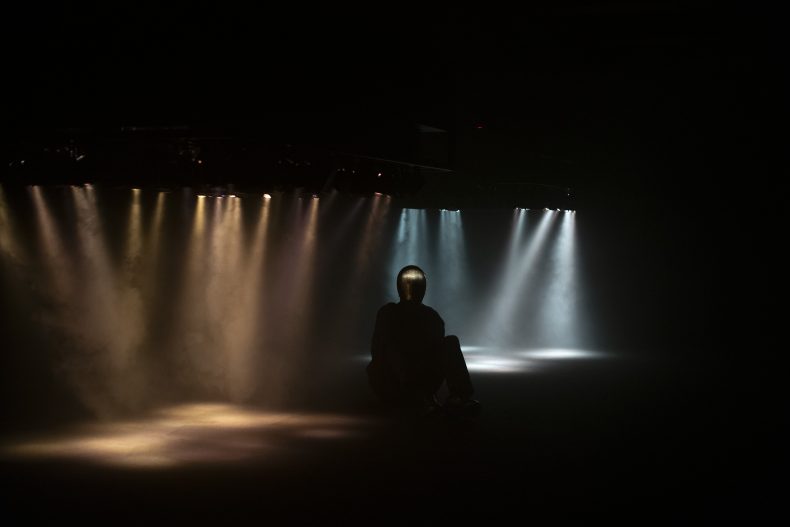From the May 2024 issue of Apollo. Preview and subscribe here.
‘I am not interested in what was,’ says Pierre Huyghe, ‘I am interested in what could have been and what could be.’ His works, over the decades, are less exhibition pieces than scenarios in which chance, contingency and autonomous development play out. Their relation to the human world is only tangential, with organisms and animals outnumbering people. Untilled (2012), for example, consists of a Max Weber sculpture of a naked woman with a live beehive for a face; for Human Mask (2014) Huyghe filmed a monkey wearing a Japanese onnamen mask of a young woman as it pottered around a deserted restaurant in post-tsunami Fukushima; for Variants, in 2021 he appropriated an island in the sculpture park of the Kistefos Museum in Norway and laser-mapped it. The resulting simulation was constantly updated with environmental information fed by sensors embedded in the surroundings and projected on a large LED screen in the woods, so there was the real island and an evolving digital version. Each piece continued to exist – and change – after Huyghe had walked away.
Huyghe says his work is not concerned with providing answers but provoking questions. One of the questions raised by ‘Liminal’, an exhibition of new and old pieces from the Pinault Collection at the Punta della Dogana in Venice, is about the nature of Huyghe’s own development – his personal ‘what could have been and what could be’.
In 2003 he made a short film, Streamside Day, in which he invented celebrations and traditions for a real new-build residential development in the Hudson Valley 70 miles north of New York City. There were retracting walls and other technological clevernesses, but also costumes, fireworks, a parade, nods to Disney films and an overarching lightness of touch. That has all gone now. The worlds of ‘Liminal’ are inert, funereal, stygian to the point of Anish Kapoor Vantablack – and where there is life it is only a half-life. What happened to Pierre Huyghe?

Liminal (2024–ongoing), Pierre Huyghe. Courtesy the artist and Anna Lena Films, Paris; © Pierre Huyghe/SIAE 2023
The other question that arises early in the exhibition is whether it is possible to appreciate what’s going on without explanation or prior knowledge of Huyghe and his interests. The works contained in the spaces of Venice’s old custom house are – ironically perhaps for a building familiar from innumerable vedute by Canaletto, Francesco Guardi and Turner – totally unconcerned with conventional aesthetics. The viewer is in the literal dark.
Here, in succession, are a series of seemingly unrelated objects and films. In a room so black that visitors bump into one another (their whispered ‘Scusi’ and ‘Sorry’ offer an alternative soundtrack) is a film of a naked woman with an oval void instead of a face. She/it moves slowly in an infinite, empty landscape – taking small steps, bending and gesturing. There is no colour whatsoever, the projection is the palest monochrome and the accompanying sound consists of clicks and blurs like atmospheric interference. The figure, despite having a human form, is inhuman.
Elsewhere, in another black room, two low-hung grids emit tubes of moving smoke lit by bleached pinkish and yellow light. A musical score, based on Erik Satie, fragments and reconfigures. Squatting just beyond the light field are still figures in full-face brass helmets – impassive as sculptures.

Installation view of (from front to back): Idiom (2024), Pierre Huyghe, courtesy Leeum Museum of Art; Offspring (2018), Pierre Huyghe, courtesy Leeum Museum of Art; Offspring (2018), Pierre Huyghe, Pinault Collection. Photo: Ola Rindel; © Palazzo Grassi, Pinault Collection; © the artist
A third room is illuminated by a huge projection. A skeleton, remains of shoes still on its feet, lies in a rocky desert; an assortment of cameras, mirrors and lunar probes circle the bones. They film in close-up, revealing their pitting and fractures, the dirt and dust that have filled in gaps where muscles were once attached, lingering with a lover’s gaze. The sun rises and sets, shadows are cast and the robotic machines try to pick up small glass spheres and polished objects resembling chess pieces that are dotted around the skeleton.
There is a wan, slow-breathing beauty to these pieces but no obvious correlation between them or hints as to what is happening. It is only on reading the gnomic text accompanying each work that meaning materialises, and even then only a semblance of sense.
In each case, artificial intelligence is used to direct the piece. The faceless woman, it transpires, is picking up stimuli from the ebb and flow of visitors, captured and transmitted by sensors in the room, and moving in response while learning from them, all in real time – building a memory as it goes. The helmets worn by the figures beyond the smoke are also receptors, turning the sensations gleaned from the physical presence and numbers of visitors, their movement, mass and voices, into a new language. The skeleton is that of an unknown migrant who died in the Atacama Desert 100 years ago – the cameras and robots around his remains perform an endless funerary rite. This film was shot over five days and is continuously self-editing, again according to changes in the exhibition environment and stimuli from the audience. It directs itself and is never the same. So human presence gives each non-human work an independent life which continues when those who engendered it have gone.

Still from Camata (2024) by Pierre Huyghe. Courtesy the artist/Galerie Chantal Crousel/Marian Goodman Gallery/Hauser & Wirth/Esther Schipper/TARO NASU; © the artist, by SIAE 2023
With this knowledge these ‘speculative fictions’ become conceptually rich: space, time, neural networks, metaphysics, the nature of life… all are at play. After all, says Huyghe, ‘Science fiction, science, philosophy are food to me.’ This does not, however, make it artistically rich. Without explanation of both the technology and intent, the pieces are mystifying, each suggesting profundity but offering no way in. A bit of mystification, a touch of the ineffable, are good things, but here there is the niggling sense of something so meaningful that it ends up carrying no sense at all. This would matter less if the works provided compensatory emotional or visual satisfactions.
Huyghe describes his role as ‘defining the conditions for the emergence of an otherness’. If this vision of an autonomous, post-human world is also a vision of ‘what could be’, it is, for all its incidental poetry, unnerving and lowering. Change and chance might yet prove transformative, though. Now that they have independent life, the works might in years hence develop into something less bleak.
‘Pierre Huyghe. Liminal’ is at the Punta della Dogana, Venice, until 24 November.
From the May 2024 issue of Apollo. Preview and subscribe here.














![Masterpiece [Re]discovery 2022. Photo: Ben Fisher Photography, courtesy of Masterpiece London](http://zephr.apollo-magazine.com/wp-content/uploads/2022/07/MPL2022_4263.jpg)
Why it’s time to stop rediscovering Eileen Gray